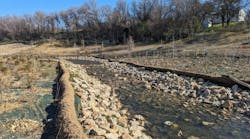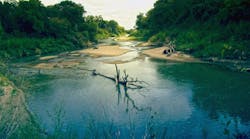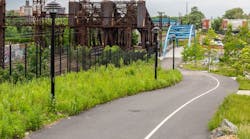A notable project case study for during- and post-construction erosion controls is the Manavon Elementary School – Phoenixville Area Early Learning Center. Although the construction period took place between 2015 and 2017, the finished site’s permanent storm water and erosion control measures were subjected to conditions far beyond the design limit by Hurricane Ida during the summer of 2021. The hurricane dropped 10 inches of storm water at the site in seven hours, constituting a greater than 1 in 1,000 year storm, far exceeding the required 100-year storm design. In fact, the storm was so severe that Chester County was one of eight Pennsylvania counties approved for federal disaster assistance. However, due to the project’s robust yet straightforward controls, it held out with no damage or erosion whatsoever.
Erosion is a natural process by which the earth gets worn down, typically by elements such as wind, water and ice. During construction, stabilizing surface treatment, such as vegetation, is temporarily disturbed and removed. At this time, storm events can accelerate erosion without proper controls in place, leading to increased sediment material being transported to water bodies as a pollutant.
Previously named one of the "10 Awesome Neighborhoods to Call Home" by Philadelphia Magazine, Phoenixville, Pennsylvania, is also steeped in history. Before the elementary school project, the site was a golf course. Prior to the golf course, it was the Moses Coates Farm, an early settlement, and the original 1754 farmhouse is still intact. The Coates’ farmstead loyally provided food, clothing and medicine to the nearby encampment at Valley Forge during the Revolutionary War. The school district presently owns the Coates building, which is intended to be repurposed for preservation.
During-Construction Erosion Controls
Any runoff that leaves a construction site must be filtered before it is discharged. If inappropriate erosion controls are used, or proper controls are not maintained, fish and other stream life can be harmed or killed. Design considerations for the Manavon project included its location situated within the high quality watershed of Pickering Creek, which serves as a major drinking water supply for the surrounding area. This required a 150-foot stream buffer setback, which could not be disturbed during or after construction, and an overall higher design standard for during and post-construction erosion and runoff control. Maintaining stability of the buffer was key and was achieved with a non-disruptive vegetation stabilization measure that reinforced the turf with a green infrastructure webbing product. With this in place, treated storm water runoff could be discharged without erosive forces that may have otherwise degraded the receiving stream.
The primary erosion control measures used during construction were sediment treatment basins equipped with surface skimmers to discharge the cleanest water from the top of the collected water column. The site required three basins in total, including one specifically to treat runoff for installation of geothermal well drilling. The school district elected to use the geothermal wells in order to reduce the carbon footprint from heating and cooling the new 152,000 square-foot building. The geothermal well basin was specially designed for overnight dewatering of the runoff from the prior day’s drilling. This specialized basin also separated the well drilling flow from the rest of the project so as not to overwhelm the balance of controls.
Secondary controls included the extensive use of compost filter socks and erosion control blankets. Compost filter socks are a tubular plastic web barrier, typically 18 to 24 inches in diameter, filled with composted material which traps sediment, and they typically filter during-construction runoff better than other materials. Erosion control blankets are rolled mats often made of straw or coconut fiber woven with photodegradable or cotton twine. Blankets, in particular, help prevent slope and channel erosion during rain events and help to provide a stable matrix for vegetation to rapidly germinate and restabilize disturbed areas.
Additionally, at Manavon it became necessary to accelerate the creation of athletic fields for the school district’s use. This required alteration to the construction sequence and removal of one of the sediment basins earlier than planned. To offset the basin’s removal, additional secondary erosion control measures were implemented to filter runoff and trap sediment, in conjunction with temporarily re-plumbing a portion of the permanent storm sewer to bypass clean water from off-site around the construction area. Construction successfully concluded with no significant issues from erosion control measures and the high quality stream maintained.
Post-Construction Erosion Controls
For any completed project, improper design for permanent erosion control can result in loss of fertile topsoil, increased flooding, increased deposit in water bodies, structural damage to buildings and roads, and damage to plant and animal life. The unmanaged concentration and discharge of water runoff from improper storm water management alone can pose potential ecological issues.
Long-term erosion control solutions include:
- Proper post-construction storm water management facility design and maintenance;
- Stabilization at discharge points, including rock rip-rap;
- Minimizing steep cuts and fills for final grading;
- Replanting native and deep-rooted vegetation to stabilize the soil; and
- Covering areas with heavy foot traffic with appropriate resilient surfaces, such as mulch or permeable pavement.
To manage storm water runoff and permanent erosion control for the developed Manavon project, an extensive series of best management practices were implemented. At- and below-surface infiltration basins were used to reduce storm water runoff volume, and a constructed wetland basin was provided to reduce runoff rates, which in turn reduced erosive forces.
The result was successful. Hurricane Ida created flows that exceeded the project’s storm water design limit by 40%. Yet, there was no surface flooding of the school site or building, and the primary outfall through the stream buffer remained entirely stabilized with no erosion. Thanks to the school’s investments in storm water resilience efforts, the facility escaped harm. The school’s commitment to resilience is built into its mission: “To prepare, inspire, and graduate students to meet the challenges of the future, while growing to become the educational hub of the community.”
It is anticipated that by 2025, NOAA will update the Atlas 14 Point Precipitation Frequency Estimates used for storm water and erosion design purposes to be increased approximately 8% as a result of climate change. Another 8% update is anticipated by 2050. In short, we will see more frequent rain events and major storms in the future. Engineers and other design professionals who seek to build new projects and structures, or improve on current ones, should take into consideration proper during- and post-construction erosion and sediment control measures that will ensure a project’s resilience to extreme rain events.






